Crepe Myrtle for the Summer Heat.
Crepe Myrtle ( Lagerstroemia) is a small , fast - growing tree for warm, temperate and cool-temperate climate zones. Native to astern Asia, it is regarded as one of the best flowering trees available, and comes in a fantastic range of colours. Masses of flowers with ruffled petals adorn the trees , making an attractive display. The tree also has an attractive trunk with smooth mottled bark. It usually flowers in Mid to late summer and has few pests and diseases, however Powdery Mildew, a fungus affecting the leaves can be a problem in more humid areas. A new variety , called "Indian Summer" has been bred for resistance to the fungus, and also comes in many great colours. Crepe Myrtles do very well in Sydney where the photos were taken. ![NEW 3 033.JPG]
Myrtle, any of the evergreen shrubs in the genus Myrtus, belonging to the family Myrtaceae. Authorities differ widely over the number of species the genus includes. Most occur in South America; some are found in Australia and New Zealand. True myrtles have a central midrib and a major vein just inside and parallel to the leaf margin.
The aromatic common myrtle (M. communis) is native to the Mediterranean region and the Middle East and is cultivated in southern England and the warmer regions of North America. In Greco-Roman antiquity, the common myrtle was held to be sacred to Venus and was used as an emblem of love in wreaths and other decorations.
The plant may grow more than 5 m (about 16.5 feet) high. The opposite leaves are thick and lustrous, with many small, translucent, oil-bearing glands. The solitary white flowers, about 1.8 cm (about 0.7 inch) long, are borne on short stalks. The fruit is a purplish black, many-seeded berry. Myrtol, a volatile oil found in most parts of the plant, was formerly used as an antiseptic and tonic.
Variegated, yellow-fruited, and white-fruited varieties of the common myrtle are cultivated for ornament. Other plants known as myrtles are wax myrtle, bog myrtle (or sweet gale), crape myrtle, sand myrtle, gum myrtle, downy myrtle, and the mountain laurel of Oregon and California, the wood of which is often sold as “myrtle.” The creeping, or running, myrtle is the periwinkle.
https://www.britannica.com/plant/myrtle
Congrats, you have shared the Fav, comment Award with one other. Great Pics and good info. Well done !!
Crepe myrtle trees, in many varieties, overlook an abundance of southern landscapes. Southern gardeners love their crepe myrtles for summer bloom, attractive, peeling bark and limited crepe myrtle care. How to grow crepe myrtle is not an issue in most areas to which they are hardy, USDA Zones 9-7 (with some special varieties surviving in zone 6), as they are easy to grow in the right location.
Crepe myrtle trees should be planted in a sunny location. Soil need not be rich or amended; crepe myrtle trees are adaptable to most soils except those that are soggy. Sunlight and well-draining soil afford a wealth of summer blooms and help keep pests away.
The difficulty most often arises when caring for crepe myrtles. Crepe myrtles trees are sometimes susceptible to sooty mold and powdery mildew, but these are easily cured with an organic spray. The most daunting and incorrectly practiced aspect of crepe myrtle care is pruning” Crepe murder usually occurs when an overly enthusiastic homeowner severely cuts back top branches on crepe myrtle trees, ruining the natural shape and form of the lovely landscape specimen.
source
Congrats, you are sharing the Fav. comment Award with one other. Great pics and helpful info.
The colorful, long-lasting blossoms of crape myrtle (Lagerstroemia indica) make it a showpiece in classic Southern gardens. But it is not a particularly delicate plant and it can thrive in conditions that would be a challenge for other plants.
Crepe myrtle are deciduous or evergreen, flowering trees or shrubs and are among the best flowering trees. Crepe myrtle is also known as the crape myrtle, and its scientific name is Lagerstroemia. There are approximately 50 species of crepe myrtle. The crepe myrtle is native to south east Asia and northern parts of Australia and Oceania. The crepe myrtle is part of the Lythracae family, also known as loosestrife.
Crepe myrtle derives its name from the crepe like look and texture of the flowers. Most crepe myrtles shed their bark during the year. Different species of crepe myrtle can be as little as 30 cm (1 foot) in height and can be as tall as 30 m (100 feet). The colour of crepe myrtle flowers come in almost any shade of purple, pink, red or white. Crepe myrtles are popular due to their long lasting flowers, which bloom in Summer and Autumn. It is not attractive to deer, so it is a good choice in areas where damage from browsing animals is a problem.
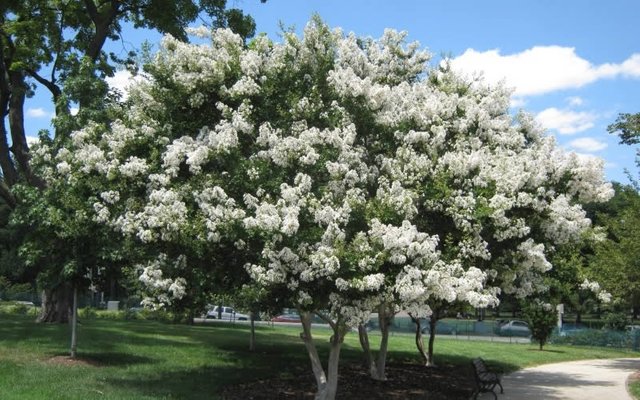
Crape myrtle's long bloom period is one of its most attractive characteristics, and given the proper growing conditions, the plant will be covered with flowers from midsummer into fall.
You have won the Silly Sausage Award for your comment and it's great pics as well as useful info. Well done !!
Thank you so much Dear @Ctrl-alt-nwo for selecting my Reply's for the Silly Sausage Award. I am really happy now.
@ctrl-alt-nwo, That would be excellent gardening explanation. It's really beautiful flowers indeed plants. I added some details from internet.
Crepe myrtle trees, in many varieties, overlook an abundance of southern landscapes. Southern gardeners love their crepe myrtles for summer bloom, attractive, peeling bark and limited crepe myrtle care. How to grow crepe myrtle is not an issue in most areas to which they are hardy, USDA Zones 9-7 (with some special varieties surviving in zone 6), as they are easy to grow in the right location.
The most daunting and incorrectly practiced aspect of crepe myrtle care is pruning” Crepe murder usually occurs when an overly enthusiastic homeowner severely cuts back top branches on crepe myrtle trees, ruining the natural shape and form of the lovely landscape specimen. Caring for crepe myrtle should include limited pruning and little removal of growing branches. Too much pruning from the top sends suckers shooting from the bottom of the tree or the roots, resulting in additional pruning and unnecessary crepe myrtle care. It can also result in an unattractive winter form.
Images found on google
Source: https://www.gardeningknowhow.com/ornamental/trees/crepe-myrtle/crepe-myrtle-care.htm
Crepe myrtle is a fast-growing deciduous tree or shrub that is particularly popular in the South and Southeast regions and hardy in zones 6 through 10. Due to its multi-stemmed appearance, the tree is commonly grown in yards and public areas for an addition of color and interest. Dwarf crepe myrtle is perfect for containers and as an accent shrub in flower beds.
In Southern climates, the crepe myrtle begins to flower mid-spring, and in northern areas, it blooms in the summer. Flowering in all regions continues until the fall. The flowers grow in 6 to 12-inch long clusters that are 3 to 5 inches wide, and clusters from the dwarf varieties are smaller.
Crepe myrtle trees are available in a range of flower colors, including purple, lavender, white, pink, and red. Some types of crepe myrtle have bicolor flowers. The bark on the plant peels off in the summer, exposing a new layer.
The crepe myrtle enters a dormant state starting in the late fall and lasting throughout the winter. During this time, the leaves fall off, but the roots keep growing.
https://www.doityourself.com/stry/guide-to-planting-crepe-myrtle
Crape myrtle is an upright deciduous tree or large shrub. Dark green leaves emerge bronze. White, pink, red, or purple flowers appear from summer to autumn. Peeling gray-and-brown bark is attractive.
Noteworthy Characteristics
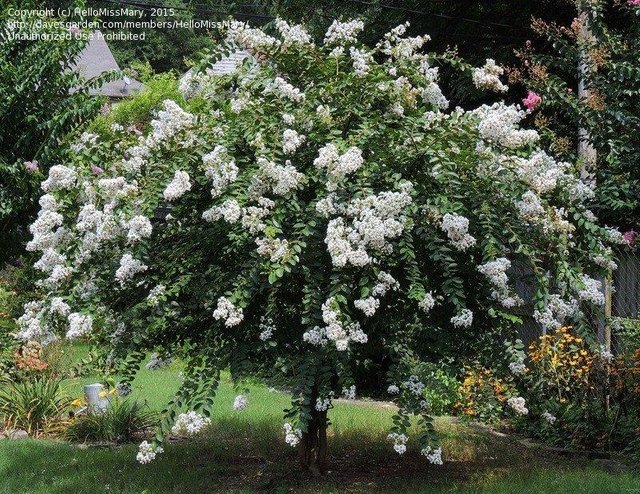
Hybrids of L. indica and L. fauriei vary greatly in size, habit, hardiness, and resistance to powdery mildew.
Care
Thrives in moderately fertile, well-drained soil. Grow against a warm, sunny wall where marginally hardy or overwinter in a greenhouse. Can be hard pruned if renovation is required.
Propagation
Root softwood cuttings in late spring, or semi-ripe cuttings in summer.
Problems
Dieback, powdery mildew, aphids, scale insects, mealybugs, and whiteflies.
Please quote your sources next time, thanks.
How to Grow Crepe Myrtle With this video Sir @ctrl-alt-nwo
Lagerstroemia (Crepe Myrtles)
The magnificent Indian Summer Crepe Myrtle (Lagerstroemia) make an ideal choice as a flowering tree in the heat of Australia's mid- to late summer. Available in a multitude of flower colours, from white through to red, and in forms ranging from shrubs to trees, they also feature exfoliating bark that gives them ornamental value even during the dormant winter months.
The Indian Summer Crepe Myrtles are beautifully complimented by their smaller-growing cousins Symphony of Colour Crepe Myrtles by Chopin. Chopins are generally available as shrubs with some of the range being grafted onto 'standards' that are an impressive sight when in full bloom.
White crepe myrtle
Crape myrtle is a very beautiful and popular flower. Lagerstroemia is it's scientific name and commonly known as Crape myrtle. Mainly Lagerstroemia is a shurb or small tree.
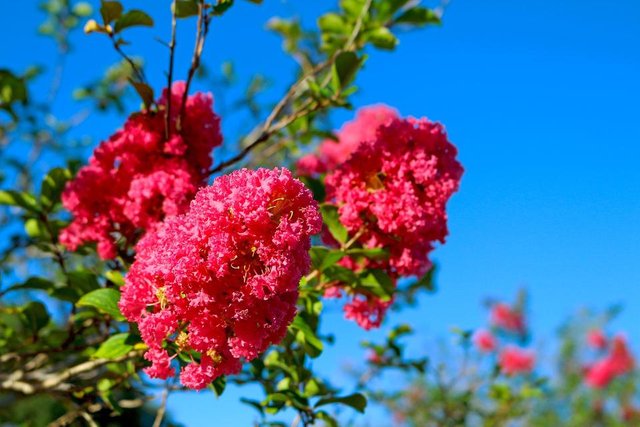
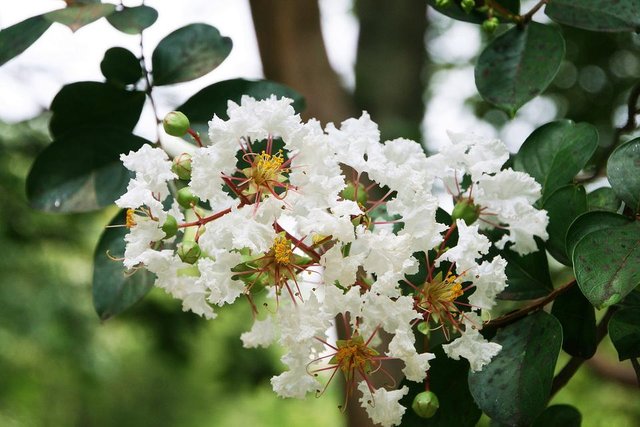
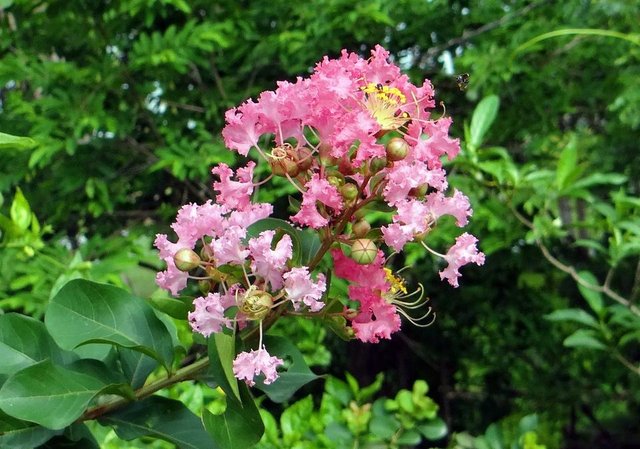
source
The flowers mainly found in southern Asia and Australia. It has many colours like red, pink and white.
source
source
Flowers is the beauty of nature. We can learn from flowers like love, peace, beauty, innocence, purity. We should plant flowers everywhere like home, school, college, office and make the world beautiful and peaceful.
Crape myrtles are wildly popular in the South for good reason. They bloom in the summer, when there are few other trees and shrubs providing that service. The larger varieties grow rather quickly, providing a bit of shade in addition to the seasonal color.
All crape myrtles are sun lovers, generally cold hardy in zones 7-10, although there are some that will work in zone 6 as well. They are extremely heat-tolerant and quite drought-tolerant once established. Plant them in full sun, amending the soil with soil conditioner to provide a moist and well drained situation.
Care is minimal for crape myrtles. Fertilize in spring with a general purpose shrub fertilizer—cottonseed meal works great—and keep it mulched to maintain consistent soil moisture and temperature. Water periodically during dry spells.
The major problems with crape myrtle include Japanese beetle, aphids, whitefly and powdery mildew. Again, providing a good location and proper sizing to fit the site will minimize most of these problems, but monitor for them and treat as needed.
Crape myrtles, like most other commercially available plants, come in a wide selection of varieties. Not only do they differ in bloom color and cold hardiness, but also in mature size, bloom time and disease/insect resistance.